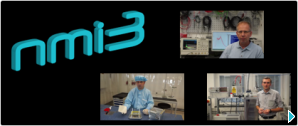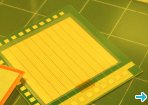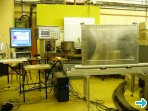Good results obtained with a novel technology to produce large-scale neutron converters
An atmospheric plasma deposition system to produce Boron-10 layers
08/09/2014
Helium-3 is widely used in neutron detectors worldwide. However, due to a 3He shortage that caused its price to rise, it is necessary to find affordable alternatives for neutron detectors. A team of the detector laboratory at the Helmholtz-Zentrum Berlin (HZB) is exploring new techniques for the production of boron-10 (10B) layers. This work is part of a Joint Research Activity on Detectors supported by NMI3. In the video, Thomas Wilpert, Andriy Styervoyedov, and Svyatoslav Alimov from HZB explain a new promising technology.
The best techniques to produce 10B layers
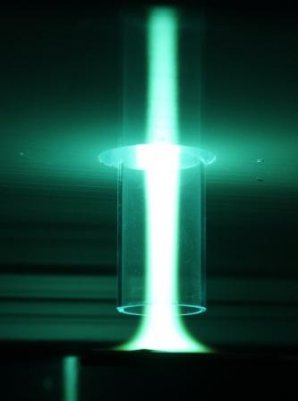
The plasma jet when borron is injected
The standard technique to produce 10B layers is magnetron sputtering, which is a vacuum-based technology that needs days of work to create one m² of neutron converter. An instrument for inelastic neutron scattering has a large detection area of 10 to 100 m2 and requires a stack of 20 to 30 10B-based layers of about 1 µm thickness to achieve satisfying detection efficiencies. Thus, in total 200-3000 m² 10B-layers have to be produced per instrument in reasonable time at affordable prices.
After exploring a number of alternative techniques suited to coat delicate aluminium substrates, the HZB team found a good candidate that could do the job: an atmospheric pressure plasma is able to produce needed converters much faster and uses the precious source material more efficiently.
Atmospheric plasma is rapidly developing direction in thin films coatings technology and it has already found industrial application in aerospace engineering, solar modules production, biomedicine and other state-of-the-art fields. Unlike vacuum plasmas, atmospheric plasmas don’t require expensive pumping systems, complex transfer chambers from air to vacuum and can be applied to a wide variety of surfaces.
The HZB Detector laboratory team has assembled the experimental set-up on the base of Atmospheric Plasma Source (APS) and after adjustment of many system parameters has received promising results in boron-10 layers formation.
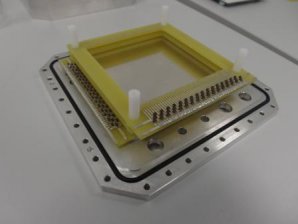
The references layers will be used in the test detector that was provided by the other JRA members in FRM II and BNC.
For comparison of the neutron absorption efficiency of 10B-based layers made by APS it is necessary to have reference layers of high quality created with vacuum plasma technique. For this purpose conventional magnetron sputtering was boosted to provide denser plasma with a higher fraction of boron ions. Boron-rich plasma leads to improved adhesion and higher density of formed layers. As a result high quality 10B reference layers were deposited at HZB using a special type magnetron sputtering and are now available for comparative measurements.
Promising results
The results obtained so far show that this new atmospheric plasma system is very efficient as it allows very high deposition rates. The HZB detector team anticipates producing one m² neutron converter within few hours.
NMI3: making strong collaboration possible
The team at HZB is very satisfied with this NMI3 JRA, as there is a strong collaboration with FRM II and the Budapest Neutron Centre (BNC). All HZB, FRM II and BNC have built common test detectors so that the performance of this new technology can be evaluated in all facilities simultaneously. Unfortunately the detector group at HZB will not continue its activities after the end of this NMI3’s phase of funding, due to the planned HZB reactor shut-down. We hope that this important work will be adopted by other facilities!
Useful links
Contact: Inês Crespo

NMI3 thanks Thomas Wilpert, Andriy Styervoyedov, and Svyatoslav Alimov for reviewing this article.
Related articles
28.01.2014 - On the way to more efficient boron-10 detectors
A team in CEA Saclay is working on a new detector that uses boron-10 instead of helium-3. You can read the article here .
01.10.2013 - Exploring alternative technologies for neutron detectors
As part of the NMI3-II Detectors JRA, scientists at the BNC explore alternatives to 3He so that neutron detectors can become more efficient and provide better data. You can read the article here .
